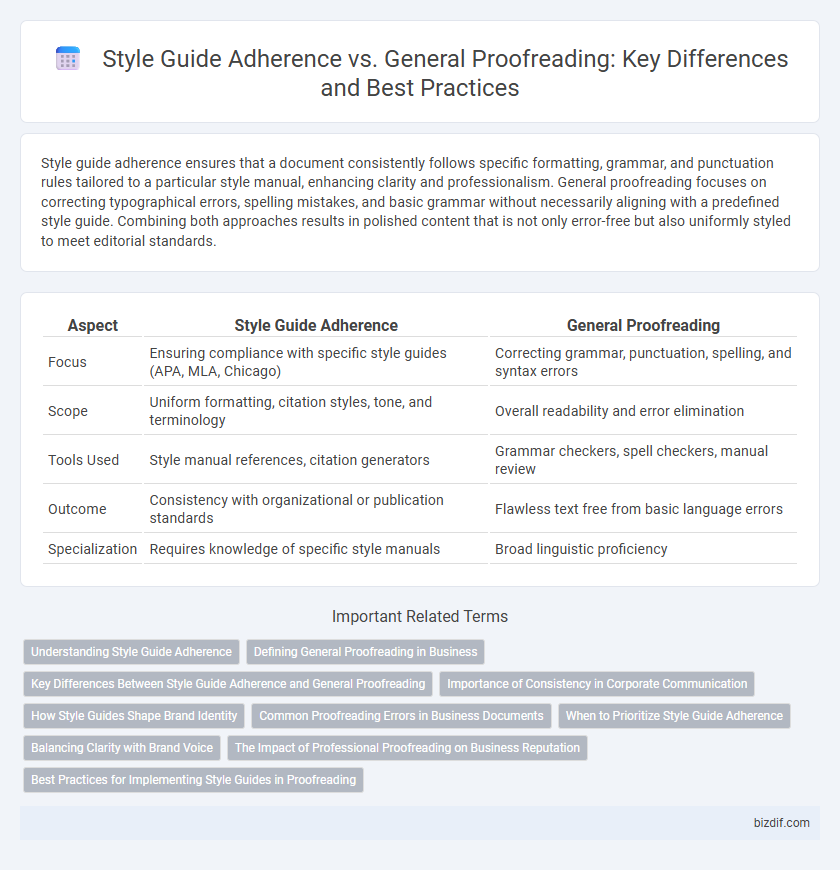Style guide adherence ensures that a document consistently follows specific formatting, grammar, and punctuation rules tailored to a particular style manual, enhancing clarity and professionalism. General proofreading focuses on correcting typographical errors, spelling mistakes, and basic grammar without necessarily aligning with a predefined style guide. Combining both approaches results in polished content that is not only error-free but also uniformly styled to meet editorial standards.
Table of Comparison
| Aspect | Style Guide Adherence | General Proofreading |
|---|---|---|
| Focus | Ensuring compliance with specific style guides (APA, MLA, Chicago) | Correcting grammar, punctuation, spelling, and syntax errors |
| Scope | Uniform formatting, citation styles, tone, and terminology | Overall readability and error elimination |
| Tools Used | Style manual references, citation generators | Grammar checkers, spell checkers, manual review |
| Outcome | Consistency with organizational or publication standards | Flawless text free from basic language errors |
| Specialization | Requires knowledge of specific style manuals | Broad linguistic proficiency |
Understanding Style Guide Adherence
Style guide adherence ensures that a document consistently follows specific formatting, tone, and linguistic rules set by organizations like APA, MLA, or Chicago Manual of Style. Understanding style guide adherence requires meticulous attention to detail in grammar, punctuation, citation formats, and typography, which enhances clarity and professional presentation. Unlike general proofreading, which focuses primarily on correcting spelling and basic errors, style guide adherence maintains uniformity and brand voice across all written materials.
Defining General Proofreading in Business
General proofreading in business involves carefully reviewing documents to identify and correct errors in grammar, spelling, punctuation, and formatting, ensuring clarity and professionalism. It focuses on improving the overall readability and consistency of business communications without strictly enforcing specific style guides. This process enhances the quality of reports, emails, proposals, and other corporate materials by eliminating mistakes that could undermine credibility or lead to misinterpretation.
Key Differences Between Style Guide Adherence and General Proofreading
Style guide adherence ensures consistency by strictly following predefined rules for grammar, punctuation, citation, and formatting specific to a particular style like APA, MLA, or Chicago. General proofreading focuses on correcting spelling, grammatical errors, and improving readability without necessarily complying with a particular style guide's detailed standards. Key differences include the precision of formatting and citation requirements in style guide adherence versus the broader, more flexible error correction in general proofreading.
Importance of Consistency in Corporate Communication
Maintaining style guide adherence ensures consistency in tone, terminology, and formatting across all corporate communications, reinforcing brand identity and credibility. Unlike general proofreading, which focuses on grammar and spelling errors, style guide adherence aligns every document with established corporate standards, minimizing misunderstandings and enhancing professionalism. Consistent messaging fosters trust with clients and stakeholders by presenting the organization as reliable and detail-oriented.
How Style Guides Shape Brand Identity
Style guide adherence ensures consistency in language, tone, and formatting that reinforces a brand's unique identity across all communications. General proofreading focuses on correcting grammar, spelling, and punctuation errors without necessarily maintaining that distinct brand voice. By strictly following style guides, businesses cultivate a recognizable and professional image that strengthens customer trust and brand loyalty.
Common Proofreading Errors in Business Documents
Common proofreading errors in business documents include inconsistent adherence to style guides, such as incorrect formatting of headings, improper use of capitalization, and inconsistent punctuation. Overlooking these issues can lead to a lack of professionalism and confusion in communication, emphasizing the importance of strict style guide adherence. General proofreading may catch spelling and grammar mistakes, but aligning with specific style guidelines ensures clarity and brand consistency.
When to Prioritize Style Guide Adherence
Prioritize style guide adherence when producing content for corporate communication, academic publishing, or brand-specific materials to ensure consistency and professionalism aligned with established standards. This approach is crucial for maintaining uniform terminology, formatting, and tone across documents, which supports brand identity and readability. General proofreading focuses on grammar, spelling, and punctuation, but style guide adherence addresses specialized rules and preferences essential for targeted audiences.
Balancing Clarity with Brand Voice
Balancing clarity with brand voice requires meticulous adherence to style guides while applying general proofreading principles to ensure consistency and readability. Style guide adherence enforces standardized grammar, punctuation, and terminology that reflect the brand's identity, whereas general proofreading addresses errors and enhances overall text flow. Effective proofreading seamlessly integrates these elements to maintain a professional tone without sacrificing clear communication.
The Impact of Professional Proofreading on Business Reputation
Professional proofreading ensures strict adherence to style guides, enhancing consistency and credibility in business communications. Meticulous correction of grammar, punctuation, and formatting errors prevents misunderstandings and portrays a polished brand image. This attention to detail significantly boosts business reputation by fostering trust and professionalism among clients and stakeholders.
Best Practices for Implementing Style Guides in Proofreading
Implementing style guides in proofreading enhances consistency and professionalism by providing clear rules for grammar, punctuation, and formatting tailored to specific industries or brands. Best practices include thorough familiarization with the chosen style guide, systematic application throughout the document, and continuous updates to reflect style guide revisions. Leveraging digital tools that support style guide adherence accelerates the proofreading process while minimizing human error.
Style Guide Adherence vs General Proofreading Infographic

 bizdif.com
bizdif.com